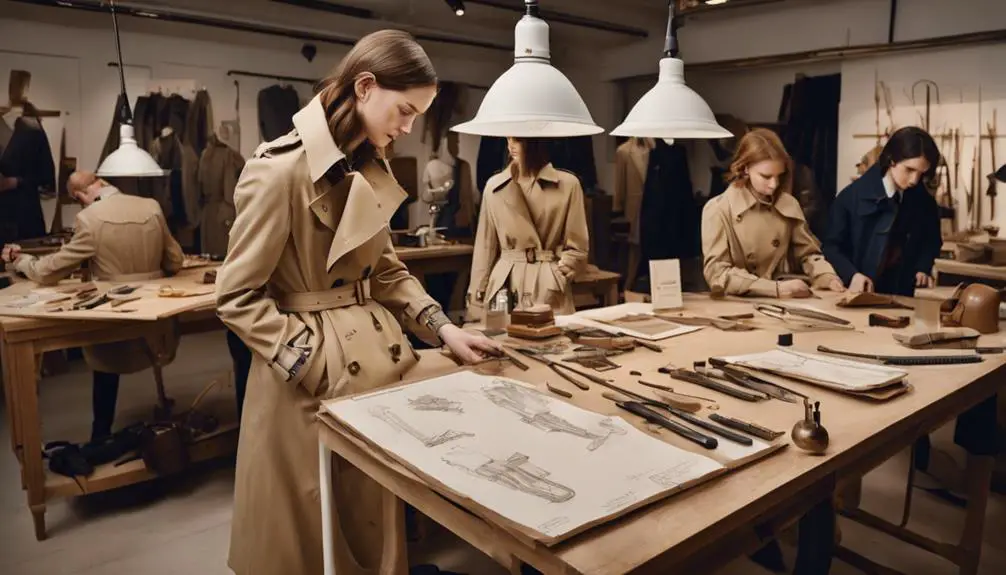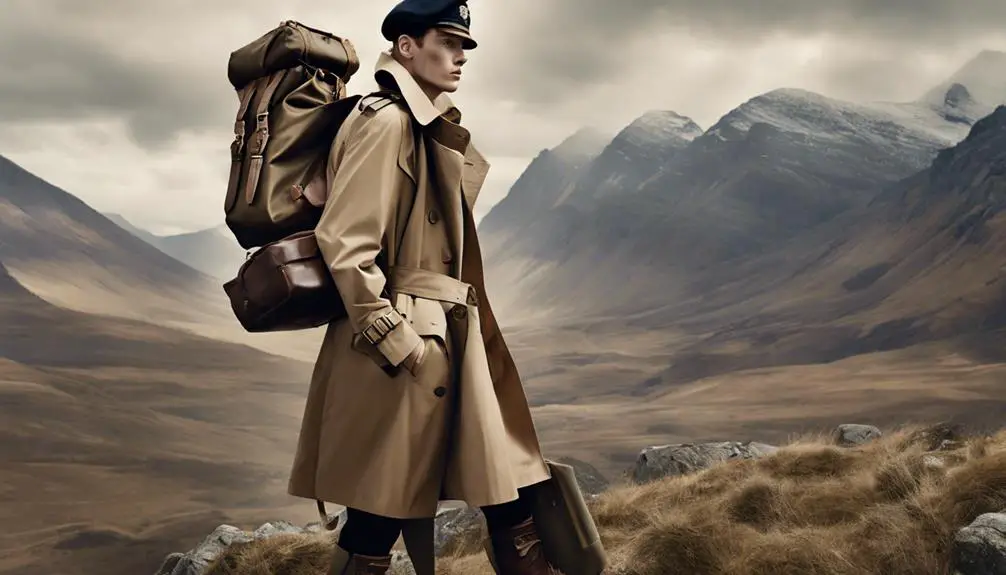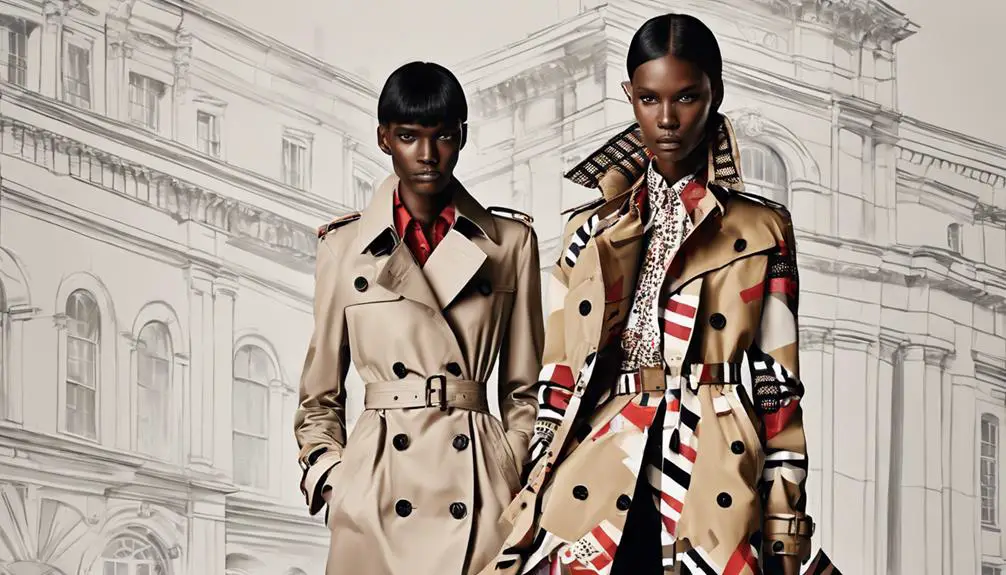When you think of Burberry, the trench coat immediately comes to mind. Designed around World War I, it combines functionality with style, using innovative gabardine fabric that's waterproof and breathable. The iconic Burberry check pattern also stands out, symbolizing luxury and heritage. Thomas Burberry founded the brand in 1856, focusing on outdoor wear. Over the years, its designs, like the Tielocken coat, have evolved yet maintained ties to exploration, being worn by famous figures like Sir Ernest Shackleton. Modern shifts by Riccardo Tisci have reimagined these classics, blending street style with tradition. There's so much more to discover about Burberry's legacy!
Founding and Early Innovations

Founding and Early Innovations
When you explore the origins of Burberry, you'll find that it was founded in 1856 by Thomas Burberry, who aimed to create outdoor clothing that provided exceptional weather protection. His vision was clear: he wanted to make garments that could withstand the harshest conditions.
In 1879, he took a major step forward by inventing gabardine, a groundbreaking fabric that was both waterproof and breathable. This innovation was patented in 1888 and transformed the way people thought about outdoor clothing, reflecting the history and evolution of Burberry in its commitment to functional design.
Burberry's gabardine fabric proved its worth in extreme situations. In 1893, Dr. Fridtjof Nansen used it during his Arctic expedition, showcasing the durability and functionality of Burberry's creations. This was just the beginning of the brand's impact on outerwear design.
In 1912, Thomas Burberry patented the Tielocken coat, which served as a precursor to the iconic trench coat we recognize today. This coat featured a unique fastening design that prioritized practicality, making it perfect for those unpredictable outdoor adventures.
Burberry didn't stop there. In 1901, the company introduced the equestrian knight logo through a public competition. This logo symbolizes Burberry's commitment to quality and its rich heritage.
The early innovations of Thomas Burberry laid the groundwork for a brand that would continue to define outdoor clothing for generations. With each piece, you can sense the careful craftsmanship and forward-thinking that started over 160 years ago.
Iconic Outerwear Designs
Iconic outerwear designs embody the spirit of adventure and resilience that Burberry has cultivated over more than a century. At the heart of this legacy lies the trench coat, first designed in 1912. Originally crafted for military use during WWI, the Burberry trench featured practical elements like map holders and straps for gas masks. This innovative approach not only served a functional purpose but also established a new standard in outerwear.
Burberry's gabardine fabric, patented in 1888, played an essential role in revolutionizing rainwear by being both waterproof and breathable. This groundbreaking material guaranteed that you could stay dry while feeling comfortable, making it a must-have for outdoor enthusiasts.
The Tielocken coat, another gem from the brand, boasted a unique fastening design and was patented the same year as the trench coat, showcasing Burberry's commitment to innovation.
As you explore the brand's evolution, you'll notice how the iconic Burberry check pattern, introduced in the 1920s, has become synonymous with British luxury. It adorns the linings of various outerwear pieces, adding a touch of elegance to functional designs.
Under the creative direction of Christopher Bailey and later Riccardo Tisci, seasonal collections have presented imaginative takes on the classic trench. From bejeweled to scarf-adorned styles, these pieces invite you to embrace the essence of Burberry while staying stylishly prepared for any adventure.
Influence of Military and Exploration

Burberry's designs are deeply rooted in military and exploration heritage, reflecting a commitment to functionality and durability. The famous Burberry trench coat, developed during World War I, is a prime example of this influence. It was crafted with practical features like map and grenade holders, essential for soldiers traversing the challenging conditions of the trenches.
You can see how the coat was designed for military utility, with large flaps for chest protection and shoulder straps to secure crucial gear. The evolution of such designs mirrors the brand history and identity that influences luxury fashion today.
But the connection to exploration doesn't stop there. Sir Ernest Shackleton, a renowned polar explorer, wore Burberry gabardine during his daring expeditions. This fabric's durability and resilience in extreme conditions showcased how the brand effectively married style with purpose.
Imagine facing the harsh winds of the Antarctic, wrapped in the warmth and protection of Burberry!
Additionally, Air Commodore Edward Maitland made history by setting a long-distance record in a hot air balloon while wearing Burberry gabardine. His adventure highlights the brand's association with exploration and the spirit of adventure that defines its legacy.
In the 1920s, Burberry introduced the iconic check as a trademark lining for its rainwear, further solidifying its ties to both military and exploratory heritage.
This blend of practicality and style has made Burberry not just a fashion choice but a symbol of resilience, adventure, and the enduring spirit of exploration.
Modernization and Brand Evolution
The evolution of Burberry reflects a dynamic response to changing fashion landscapes and consumer preferences. Since Riccardo Tisci joined as Chief Creative Officer in 2018, the brand has undergone a remarkable transformation that embraces both its heritage and modernity.
Here are three key elements of this brand evolution:
- Rebranding Efforts: Tisci introduced a new logo and a modernized monogram, breathing fresh life into Burberry's identity while staying true to its roots.
- Blending Styles: His debut collection showcased a mix of traditional British styles and contemporary streetwear, featuring iconic pieces like the trench coat, deconstructed macs, and tailored suits.
- Celebrating British Identity: Tisci revived the cherished nova check pattern and galloping knight logo, reinforcing the brand's British essence in a post-Brexit world.
Throughout Tisci's tenure, Burberry successfully intertwined modern aesthetics with its classic designs.
The Autumn/Winter 2019 collection displayed oversized puffers alongside classic duffle coats, highlighting the brand's versatility.
In his final show in Spring/Summer 2023, Tisci took bold steps by transforming classic trench coats into stunning ballgowns, showcasing a significant leap in the brand's evolution.
This modernization reflects not only a response to current fashion trends but also a commitment to evolving Burberry's legacy.
As you explore the brand's journey, you'll see how it continues to adapt and captivate, ensuring its place at the forefront of the fashion industry.
Riccardo Tisci's Reimagining of Burberry

Riccardo Tisci's arrival at Burberry in 2018 marked a pivotal moment in the brand's history, as he sought to blend contemporary street culture with classic British heritage. Taking on the role of Chief Creative Officer, Tisci aimed to revitalize this iconic heritage house, making it relevant for a new generation.
One of his standout achievements was the reimagining of the iconic trench coat, which he transformed with innovative designs that still honored its storied past.
In his debut collection, Tisci drew inspiration from Massive Attack, incorporating deconstructed macs and 1980s silhouettes that breathed new life into Burberry's offerings. You could see how he celebrated British dualities in the AW19 collection, merging traditional styles with vibrant streetwear.
The show at Tate Modern created a unique audience experience, showcasing the brand's evolution while paying homage to its roots.
As Tisci continued to refine Burberry's aesthetic, he reintroduced the galloping Knight logo during his final show for SS23. This collection reflected confidence and a strong sense of British identity.
Throughout his tenure, Tisci brilliantly balanced the brand's rich history with a modern twist, ensuring Burberry remained a standout name in British fashion.
In essence, Riccardo Tisci's vision transformed Burberry into a dynamic brand that resonates with contemporary consumers, proving that a heritage house can evolve while staying true to its roots.



